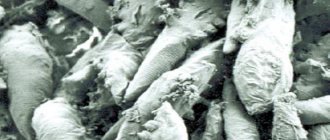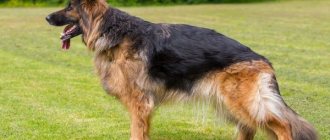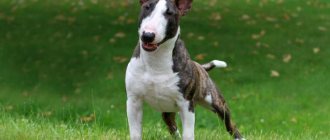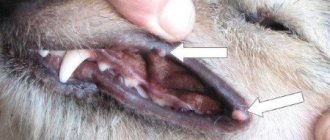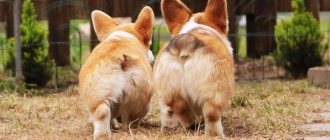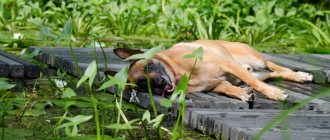Have you ever noticed how many toes a dog has on his front and back paws? You may have never noticed, but dogs have 5 toes on their front paws and 4 on their back paws.
However, sometimes we can see dogs with 5 toes on their hind feet, and some even with 6 toes, which are called “spurs”. Don't be alarmed if this is your case, we will share with you all the necessary information so that you know what this feature is about and what you should (or shouldn't) do. Continue reading this article and find out why a dog has 5 toes on its hind feet.
Why do some dogs have spurs?
Spurs, or "extra toes" on the back feet of dogs, are primarily due to the genetics of a number of specific breeds, although it can occur in almost any dog. This characteristic does not indicate any health problems and is not a disease or developmental defect.
It is believed that this claw, which we can see on the hind legs, could serve them for greater support, and that this is due to the adaptation of certain races to the environment, however, there are no studies confirming its usefulness, so there is reasonable doubt about the truth this theory. We must emphasize that this fifth toe is different from the others and is also weaker and offers less support than the others.
Finally, we remember that although some dogs have five toes on their hind feet, this characteristic does not pose a health problem, however, when we talk about a “double spur”, that is, six toes on their hind feet, we would be faced with a genetic disease called polydactyly.
Interestingly, polydactyly is a desirable or obligatory condition in certain dog breeds, which we will mention below, which is why it is mentioned in the morphological standards of certain dog breeds.
What are the symptoms of dislocation in dogs?
Symptoms vary depending on where the joint is dislocated. Dogs typically present with lameness, which can progress over time. Swelling forms around the joint.
Other symptoms:
- the limb dangles or moves in an unusual direction;
- the paw is bent and the pet does not step on it.
The joint continues to be held together by the pet's thick tendons. All breeds can suffer from dislocations, but some are more likely to experience pathologies. Thus, German Shepherds often suffer from hip dysplasia.
Dog breeds with spurs
The standards for various dog breeds include a 5th toe on the hind paws. Among them are the Pyrenean Mastiff, Spanish Mastiff, Saint Bernard or Basque Shepherd Dogs.
Although in some cases it may be due to a genetic condition, it is not believed that the spur should be trimmed or excised unless it poses a health problem for the dog. In any case, the veterinarian should recommend cutting off the toe or not.
On the other hand, remember that any other dog, regardless of breed, can have a spur or double spur. Some examples are the German Shepherd, the Rottweiler, and even small breeds like the Yorkshire Terrier or Poodle.
Anatomy of the front legs of a German Shepherd
The dog's front legs support the body and cushion the body when moving. When in contact with the ground, they take on the weight of the body, experiencing the greater the load, the higher the speed of the animal. If the German Shepherd has the correct build, the forelimbs do not take part in pushing, but perform only a supporting function.
The key role in the distribution of balance is given to the scapula. It is tilted 45 degrees to the horizon, quite long and wide. Thanks to these characteristics, the dog acquires a high forward position, which is also supported by the long humerus.
The front legs are connected to the body by strong muscles and have no bone attachment. Therefore, the dog must have well-developed muscles and elastic ligaments.
Problems that a spur or double spur can cause
A spur or double spur on the hind feet are toes that are not attached to the dog's leg in the same way as the other toes on the hind feet. There is only a connection of skin and muscle, no bone, so this characteristic can lead to certain health problems. It is important to note that in some cases we may even see a dog's spur on the front leg, although this is very rare.
Here are some consequences of this hereditary characteristic:
- Is torn;
- Infections;
- Inflammation;
- Nail partition;
- Broken nail.
Since there is no bone to support the fifth or even sixth toe, it can get stuck in the fence and cause the nail to peel off or break or split, causing pain and suffering for the dog. It also happens that these toes, while not in contact with the ground, do not wear out like the rest of the nails, so it may happen that the dog's spur may eventually become ingrown. If left untreated, the spur can become infected and inflamed.
What is the size of paws in dogs?
There are a huge number of provoking factors. The main reason is considered to be raising suckling puppies in an overly narrow pen.
The size of a dog's front paws.
Main provoking factors
The main reasons for the development of markings include:
- Excess animal proteins.
- Deficiency of animal proteins.
- Excess minerals.
- Mineral deficiency.
- Insufficient walking.
- Excessive physical activity.
Insufficient walking of the dog can lead to the development of markings.
There are cases of genetic predisposition to breeding. This is due to the incorrect structure of the ligamentous apparatus.
Other provoking factors
Other reasons for the progression of this pathology include:
- Rapid growth of the puppy.
- Slippery floors.
- Quick change of teeth.
The rapid growth of a puppy is one of the causes of pathology.
What to do if your dog twists his paw and is limping
Sudden lameness means your pet is unable to fully use a joint due to ligament damage, dislocation or fracture. If this condition lasts more than 1 day, then you need to show it to the veterinarian.
A dislocated paw in a dog can be:
- congenital - it cannot be completely treated, but the paw can be developed with the help of massage and an orthopedic orthosis or bandage;
- traumatic;
- pathological - occurring due to pathologies of cartilage tissue.
Important! Puppies under 1 year of age are less susceptible to dislocations, as their thin, immature bones are more prone to fractures.
If you have any problems with walking or posture, you should take your dog to the veterinarian to correct the problem and prescribe supportive treatment.
First aid
If the dog does not stand on its paw, then:
- Start your inspection with the pads and fingers. Perhaps a thorn or other foreign object is stuck between them. There is redness in the place where it is located.
- Press gently. If your pet withdraws its paw, then you have found the problem.
- All that remains is to carefully remove the thorn with a sterile needle and treat the damaged area with an antiseptic.
The displacement will be accompanied by swelling of the joint and pain on palpation.
First aid will be as follows:
- The joint must be immobilized using a medical splint or improvised means.
- For severe pain, give painkillers.
- If there is damage to the skin, treat with an antiseptic before applying a bandage. For example, hydrogen peroxide or Chlorhexidine.
- Apply an ice pack to the area of swelling for 15 minutes to reduce swelling, and then take your pet to the vet.
- Transport an injured animal carefully. Small dogs are carried with the head and hips supported. Place the large one in the back seat on a blanket.
The main groups of drugs recommended for pain relief:
| Group name | In addition to relieving pain, the drug also: | Medicines |
| Nutraceuticals | have an anti-shock effect, used after an accident | "Travmatin", "Travmel" |
| Analgesics | relax muscles, relieve fever | "Baralgin", "Analgin" |
| Anti-inflammatory | lower body temperature and reduce inflammation | "Ketofen", "Maloxyvet", "Phenylbutazone", "Maloxyvet", "Carprofen" |
| Antispasmodics | relieve muscle spasms | “Noshpa”, “Spazmalgon”, “Papaverine” |
| Nonsteroidal anti-inflammatory drugs | used to treat chronic joint diseases | “Norocarp”, “Ketorol”, “Nebedolak”, “Nimesulide”, “Onsior” |
| Opioids | block pain impulses, used for anesthesia | "Tramadol" |
Important! It is forbidden to give dogs drugs for humans
—
"Ibuprofen", "Indomethacin", "Ketorol". It is extremely undesirable to give Nurofen - it provokes bleeding.
Diagnostics
Diagnosis of a dislocation begins with:
- physical examination of the animal;
- radiographs.
The veterinarian may also need information about when and under what conditions the injury occurred if it is an old dislocation. Although laboratory tests are not needed for diagnosis, your doctor may recommend blood or urine tests to determine your dog's ability to tolerate anesthesia during treatment.
Features of treatment of different types of dislocation
The closed form of dislocation is treated:
- Returning the joint to its original position. It is easier to work with relaxed muscles, so your doctor may suggest general anesthesia.
- An x-ray is then taken to confirm the normal position of the bones.
- A fixing bandage is applied and supportive treatment is prescribed.
If the ligaments are damaged, surgery may be required. Depending on the degree of damage, screws and pins are used to reproduce the normal position of the torn ligaments and hold the joint in place.
Important! Pets who have suffered a dislocated hip will be more likely to suffer from arthritis as they age. Therefore, they need to be added to the diet with Glucosamine and Omega-3 and 6 fatty acids to support the normal functioning of the joints.
The prognosis for a dislocated joint is usually good. But 1-2 weeks after removing the splint, you need to limit your pet’s activity for some time (up to 1 month). Keep the bandage clean and watch for swelling. If there is swelling, you need to loosen the bandage. But it is better to do this at the veterinarian.
In addition to the reduction of the joint, the following will be prescribed:
- non-steroidal anti-inflammatory drugs to relieve inflammation;
- immobilization or use of additional orthopedic devices to assist the composition;
- massage;
- diet.
Front or back paws
If your pet is in severe pain, do not try to examine his paw yourself. By doing this, you only cause unnecessary suffering - in pain, a dog can even bite its beloved owner. To make a diagnosis and realign the joint, the animal still needs the help of a doctor.
Treatment for displacement on the front or back paw will be standard:
- The veterinarian will take an x-ray.
- Then the joint will be realigned.
- Check the accuracy with the following photo (if necessary).
- Apply a fixing bandage. The approximate fixation period is 2 weeks. During this time, the bone cavity is filled with new tissue, and the muscle takes its usual shape.
- After the bandage is removed, physical therapy will be prescribed. Its goal is to restore normal blood circulation in the joint.
Knee cap
A dislocated kneecap is usually due to a birth defect, but can also be the result of injury. The pathology is common among young dogs and small breeds including: Yorkshire Terrier, Pomeranian, Boston Terrier, Pekingese, Papillon, Jack Russell Terrier, Maltese.
Amputation of the first dewclaws in puppies over 21 days of age
The dewclaws in dogs are the fifth digits on the hind limbs, the need for which has disappeared during the evolutionary process. Most show dogs have them removed at an early age because they impede movement, but in a number of breeds, such as the Pyrenean Mountain Dog and the Briard, they are a breed feature, and they must have two dewclaws on each metatarsus.
Figure 1 – Dewclaws on a dog.
Poodle breeders remove not only the dewclaws on the hind legs, but also the fifth toes on the front legs, which are left untouched in most dog breeds.
Why do dogs have dewclaws?
The mode of inheritance of extra digits (polydactyly) on the forelimbs is unknown. Some authors believe that dewclaws on the hind limbs are dominant over their absence. This is typical for German Shepherds, who have practically no dewclaws, as well as for marriages. The situation is different with collies and border collies. Regarding the latter breed, parents who do not have dewclaws may well produce offspring that will have them. This suggests that dewclaws are a recessive trait in this breed. Scientific studies have revealed that in dogs carrying one dewclaw gene, its phenotypic manifestation was only in 47% of them, and not in all, as would be expected. As for double dewclaws (Fig. 2), geneticists believe that this trait is recessive in relation to single dewclaws. Single and double dewclaws are autosomal dominant traits that are independent of each other. Some dog families may carry both of these genes.
Figure 2 - Double dewclaws.
During the neonatal period, dewclaw amputation and tail docking are practiced in dogs of many breeds. The best time to perform these operations is the 1st week of life.
During this period, puppies are insensitive to pain, and therefore surgery can be done either with or without local anesthesia.
Why is it necessary to remove dewclaws?
Dewclaws are usually removed from the hind legs. Due to the absence of flexors and extensors, they are functionally inactive. The claws on these fingers do not wear off, break easily, or tend to grow into the skin of the limb. For an adult dog, dewclaws are a big hindrance when walking and running. They are injured when moving on loose soil, snow, etc. Therefore, as well as for cosmetic purposes, it is recommended that puppies have their dewclaws surgically removed no later than 2-3 months of age. On the front legs, the dewclaws are not removed, since they are equipped with flexors and extensors and the dog can control them.
In which breeds is it recommended to remove dewclaws?
Dewclaws are removed from the following dog breeds:
- Alaskan Malamute
- Belgian raspberry
- Belgian Cattle Dog
- Belgian Tervuren
- bernese mountain dog
- boxer
- weimaraner
- East European and German Shepherd
- Dalmatian
- Dandie Dinmont Terrier
- cardigan welsh terrier
- Komondor
- Carrie Blue Terrier
- lakeland terrier
- Moscow watchdog
- Norwegian elk dog (elkhound)
- papillon
- Saint Bernard
- Siberian husky
- Silky Terrier
- Sheltie
- Chesapeake Bay Retriever
In which dog breeds is dewclaw removal prohibited?
According to the breed standard, amputation of dewclaws is prohibited in:
- Briard
- Pyrenean mountain dog
Dogs of these breeds must have two dewclaws on each hind limb.
How is the operation performed?
The operation is carried out as follows: prepare the surgical field - cut the hair, wipe the skin with antiseptics; infiltration anesthesia is used. If there is a joint, then anesthesia is injected around it and into the glenoid cavity. To remove a finger, you must have large hemostatic tweezers, pointed scissors or a scalpel.
After the onset of pain relief, after 3-5 minutes, the clamp is applied to the finger behind the joint. If there is no joint, then this is done as close to the metatarsal bones as possible. Then the finger is cut off with scissors or a scalpel. The finger that has the joint is removed by inserting scissors or a scalpel into the joint space. After the bleeding has stopped (in puppies it is insignificant), an interrupted suture is placed on the edges of the wound and the postoperative wound is treated. As a rule, healing occurs by primary intention. The sutures are removed on the 7th day. In adult dogs, the sutures must be protected from licking (protective collar) and treated daily with antiseptic agents; the sutures are removed after 10-14 days.
ATTENTION!!!
The younger the puppy, the less discomfort this procedure gives him.
